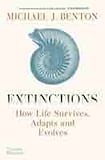
Life emerged on our planet some 3.7 billion years ago, and in the period since it has almost been extinguished at least five times by extinction events. These are called “the Big Five” and each is described in scientific detail by author Michael J Benton.
The damage to life has been done either by large meteorites impacting the Earth, producing atmospheric dust and causing global temperatures to plummet, or through volcanic activity, over thousands of years, which put greenhouse gases in the atmosphere, increased temperatures and acidified the oceans.
The author tells us that humans now have the same potential to extinguish life as these awesome forces of nature. Our emissions of greenhouse gases, over a couple of hundred years since the start of the industrial revolution, means we are living through a man-made extinction event called the Anthropocene.
We are losing plant and animal species at an alarming rate, and the only question is how bad things will get, or if life will survive the onslaught.
How a hotter world is affecting Ireland in five graphics
Easter is coming: hold off on the extravagant egg packaging
‘Incredible - real David Attenborough stuff’: thousands of young sharks discovered off Ireland’s west coast
Connemara offshore wind farm will not go ahead, dealing blow to Government’s climate targets
The Permian-Triassic extinction event, some 250 million years ago, was when life on Earth came closest to extinction, the author writes, with 90-95 per cent of species wiped out, before rebounding stronger and more diverse.
The most famous extinction event, the author tells us, is perhaps the sudden K-T Cretaceous-Tertiary mass extinction 66 million years ago, which killed off the dinosaurs and three-quarters of the plants and animals species on Earth.
The author describes how scientists discovered, by a telltale iridium layer in geological sediments around the world, all of the same age, that the K-T extinction was caused by the impact of a huge meteorite into the Yucatan peninsula in Mexico.
Sustained volcanic activity, or hyperthermal events, leads to the creation of “acid rain” and the acidification of the oceans – two processes that kill many species of plants and animals.
The author does a good job of describing what Earth was like at the time of the various extinction events, and how species may have reacted to what was happening.
Ultimately, though, this book is a cautionary tale, about how fragile life is on Earth and the huge natural processes that can extinguish it.
The author says that we have become a force of nature, with powers of extinction, as we push as much greenhouse gas into the atmosphere in a few hundred years, as it would take thousands of years of volcanic activity to achieve.















